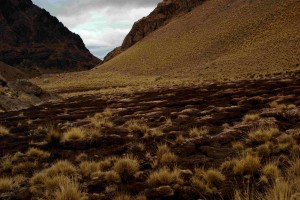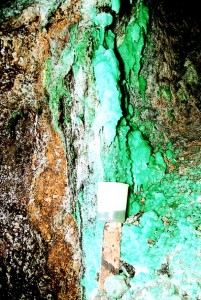It takes a few days to adjust to life at 13,300 feet in Potosi, Bolivia. As soon as I touched down in the tiny airport, I remembered the time I climbed Mt. Whitney and got desperately sick in camp at 13,000 feet. Whitney is the highest point in the lower 48 at 14,500. To visit Bill Strosnider’s research sites here, I’ll have to go way above 15,000.
I was sent here by Rotarian Magazine for an assignment to look at mining discharge. Strosnider, an environmental engineering professor from Saint Francis University who studies water pollution here, takes me around to a few pools whose pH gets down to the mid twos (about equal with lemon juice or vinegar). Their water is a deeply disturbing orange and and any fish are long since dead. But on the last day Strosnider takes his students to another site, far from his standard research area, on a quest to find something very special. “Here, hold these,” he says at the hotel when he gets back, producing a pair of bottles after asking me to close my eyes. “Can you feel the difference?” Sure enough, one of the bottles is far heavier. Opening my eyes I see that it looks like an orange sort of runny syrup and feels like it’s full of lead. And indeed, it kind of is. “It’s got iron, zinc, and aluminum,” he says. “Normally, metals are in micrograms per liter. This is just in grams. I mean, look at it.”

Essentially, there is about a million times too much metal in this water. Shockingly, this is water from pools downstream of one of the mining operations here. Strosnider was there hoping to sample one of the few places in the world where water pH in nature gets below zero (so, more acidic than battery acid).
For those who remember their high school chemistry, acidity is the proclivity for a compound to steal negative charges or give off positive ions (usually in the form of hydrogen or H+). The pH scale goes from 0-14 with 7 in the middle. Higher numbers are basic, lower ones more acidic, or put another way have way too much H+ flying around. But there’s nothing stopping compounds from going below zero – way below. Negative pH is very rare outside of a lab but shockingly, here in Bolivia it’s not created by people dumping horrible toxins in the water, it happens nearly on its own (with a tiny nudge).
It turns out that the mountains here, like many mountains, have high concentrations of pyrite – FeS2 if you are a scientist, “fool’s gold” if you watch a lot of westerns – which is made of a bad marriage between iron and sulfur. If pyrite is oxidized – say, slammed with a bunch of air and water all of a sudden – the sulfur ion is all too happy to run off with the water molecules to form sulfuric acid (I imagine the sulphur ion living out its dream of becoming a photographer in Madrid, supported by the water molecule). Meanwhile, the iron atom (who becomes a jilted, bitter little ion, telling smaller atoms how non-metals will just break your heart) spirals into a cycle of depression and alcoholism.
 The iron, highly positive in charge but feeling pretty negative, grabs the first oxygen and hydrogen it sees and has its way with them – creating a water molecule (he probably won’t pay child support on) while getting even more charged up (meaning acidic, though the pH hasn’t yet sunk). Finally, it grabs a bunch of water, rips it apart in a jealous rage and takes the negative part (OH, or hydroxide, well-known for its starring role in alcohol) for himself, ditching the last H+ to fend for itself.
The iron, highly positive in charge but feeling pretty negative, grabs the first oxygen and hydrogen it sees and has its way with them – creating a water molecule (he probably won’t pay child support on) while getting even more charged up (meaning acidic, though the pH hasn’t yet sunk). Finally, it grabs a bunch of water, rips it apart in a jealous rage and takes the negative part (OH, or hydroxide, well-known for its starring role in alcohol) for himself, ditching the last H+ to fend for itself.
More H+ means a lower pH, then more pyrite dissolved, and it just spirals into subatomic story of pain, broken marriages, and really acidic water. This whole scenario is called “acid mine drainage” and is responsible for some of the nastiest water on Earth.
Notice that the only thing you need here is water, air, and pyrite. Before humans discovered silver here, the Bolivian mountains had long come to terms with their abusive iron atoms and locked them away from view. But as miners dug into the land, they expose the pyrite and often hit the water table, releasing the iron atoms to rage on the world. And the worst thing is that the super acidic water tends to dissolve whatever it sees – rocks, water, plants. Included in those rocks are metals like cadmium, zinc, aluminum, lead, and arsenic, who become really unfriendly to living things when their own marriages dissolve (and who can blame them, really?). But, in some cosmic twist, you can’t remove the toxic metals unless you get the pH up – which caused the problem in the first place and keeps getting lower.

“The regulations tend to be a bit stricter in the US than they are in other countries. So a lot of US mining companies go elsewhere to mine, where they don’t have to worry quite so much about the regulations,” says Kirk Nordsrom, a USGS expert in mine drainage and the world’s most acidic water.
Nordstrom discovered negative pH water at California’s Iron Mountain in the 90s, which shocked even the companies that had built the mines in the first place. In that case, bacteria and archaea seem to be further exacerbating the problem by convincing iron atoms to go on Facebook and look up old girlfriends.
The acidity and lethal metals have been killing fish and other animals for over 100 years. And yes, we’re still paying to clean it up (though Nordstrom hasn’t been back inside since the air literally dissolved his wooden access ladder). In Bolivia, the pock-marked hills make Iron Mountain look positively responsible.
Strosnider has been working here to improve the situation (with a little subatomic counseling and therapy, but you’ll have to read the article when it comes out for that) but it’s a long road. The day he showed up to sample his water, a freak storm diluted it to just above zero, thus stealing his moment of glory. Then, as he was packing up to leave, he noticed a local miner leaving the mine. The miner walked up to the fetid orange pool, put his callused hands in, and washed up for the day.
First two photos by Erik Vance, second from Shutterstock, and the third from Kirk Nordstrom
I’m curious about that last miner — if this water can dissolve rocks, can it dissolve skin? What’s the effect of this water on the body?
Good question. Actually, low pH doesn’t guarantee movie-like burning acid. That’s based on concentration. In this case, There’s enough other crap in the water that the burning would only start if you went for a swim, and then just enough to turn your body red and maybe remove the hair. Just as worrisome though are the carcinogens on his hands now.
Hey Eric I’m an environmental engineering PE who’s doing a lot of the same work as the guys you are writing about, but here in the states.
Just wanted to say I absolutely laughed out loud about your description of pyritic oxidation… really good stuff and a great way to make it relateable to the layman. I passed it around the office. Might even help me to remember the mechanisms sometimes… that damn bitter iron.
Thanks for informing folks and keep up the good work!
-Devon
“I absolutely laughed out loud about your description of pyritic oxidation…” Ladies and gentlemen, this is a momentous moment. That is probably the first time in human history that this particular sentence has ever been written. Thank you, Devon.
And to be fair, that sulfide ion knew what the iron was like when they bonded. She is partly to blame, I suppose.